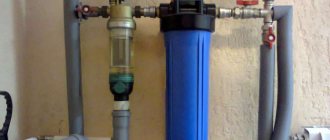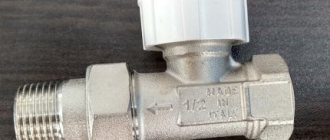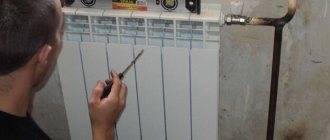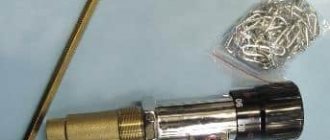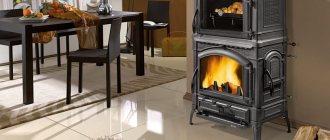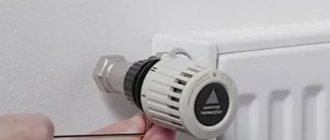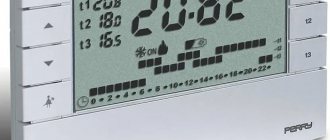A thermostat for heating radiators is a useful device for saving resources. With its help, the pressure of the coolant is reduced, regulating the heat transfer of the surface and maintaining the necessary heat in the room. Let's consider its design, installation stages, and selection features.
Installation of a thermostat on a battery Source otoplenie-gid.ru
What are thermostats for?
The weather in the winter months changes from severe frosts to thaws with positive temperatures and vice versa. In such situations, the heating system experiences high loads, which can lead to burst pipes. This is where a thermostat for heating radiators comes to the rescue, which is installed on each radiator over the entire area.
In private households it is possible to create different climates in individual rooms, depending on the preferences of the residents.
Private houses in which heating systems are equipped with thermostats for radiators are able to create a different climate in each room, according to sanitary standards and personal preferences. This design adds comfort in the winter months and decisively saves the homeowner's budget.
Benefits of temperature controllers on a heating radiator:
- The owner does not need to constantly monitor the operation of the sensor; the process is automated;
- The ability to distribute heat to different rooms, depending on needs;
- Reducing energy and fuel consumption, saving your home budget;
- In an emergency, only one battery is switched off.
The thermostat screen shows the battery temperature Source pengepugeren.dk
FAQ
What happens if you install regulators of reduced resistance on the 2nd tube? What could this mean other than overspending?
You want to put an expensive model where you can get it cheaper. This is not advisable. In general, nothing will explode and nothing will fall off. This may result in incorrect operation of the regulator.
Is it possible to regulate the heating of the battery with a ball valve to shut them off?
The ball valve has only 2 positions: open and closed. It is impossible to regulate the heating by setting it to half position. The faucet will quickly fail due to the accumulation of salt and pieces of rust and will stop turning.
From an economic point of view, installing thermostats is especially advisable in private houses with autonomous heating. In apartments with a centralized coolant supply, the use of these devices will help improve the microclimate, achieving a comfortable mode without radically blocking the radiators and systematic ventilation.
Device and principle of operation
The main effect of the design is aimed at reducing the speed in the fluid supply circuit.
The main components of the thermostat for the radiator:
- Thermal valve – flow regulation.
- Thermal head – control of valve operation.
Thermal valve device for a heating radiator:
- The body is made of stainless steel, brass or bronze, which has high corrosion resistance. The top is covered with an additional chrome protective layer. There are nickel plated cases. The inlet is equipped with a thread, the outlet is equipped with a fitting for connecting to the pipeline. The marking indicates the direction of flow, which must be strictly adhered to when docking;
- Valve – allows fluid to pass or stop. Equipped with a rubber valve;
- Rod - is responsible for the size of the gap in the pipe that allows coolant to enter the system;
- The bellows (pusher pin) is the basis of the thermostatic design.
Thermostat device Source termogolovka-ec.ru
Appearance
In the photo, the thermostat for the heater is a compact adapter with a plug. On the front side of the case there is an LCD display, a socket for connecting an electric heater and a control panel consisting of on/off buttons and temperature background adjustment.
Inside there is a microprocessor with sensors, relays or a metal plate. We'll tell you why they are needed further.
Valve Features
Depending on the method of installing the section, the following types of thermostats for the battery are produced, differing in the shape of the body :
- Straight;
- Corner with vertical and horizontal arrangement;
- Three-way with connection to bypass, valve and pipe.
By thread size : ½, ¾ and 1 inch.
According to the heating system:
- Single-pipe – volumetric with a wide cross-section in the passage. Preferable for devices with low hydraulic resistance in the line;
- Double-pipe - withstand significant pressure in pipelines. In them it is possible to regulate the flow of coolant in cubic meters per hour.
By marking:
- For pipes with natural circulation and moderate pressure in the pipeline - index G;
- With forced circulation and high hydraulic resistance - N or D.
Types of thermal heads Source www.teplomatica.ru
Design and purpose of the bellows
The advantage of bellows thermal heads is their complete autonomy, without additional power. They operate automatically without human intervention, around the clock all winter. It is enough to first adjust to the specified parameters.
The operation of the bellows is based on the first law of thermodynamics - expansion of liquid media in a hot state.
A small spring-loaded cylinder filled with a liquid or gas (thermal agent) with a high coefficient of expansion. Paraffin, which has a low melting point, is used as a liquid.
When heated, it greatly increases the volume and props up the rod, which pushes the valve that closes the passage. The cross-section of the passage narrows and ceases to allow coolant to pass through. The section does not receive enough heat and cools down to the specified norm, and with it the temperature agent. As the liquid cools, it takes on its initial volume, and the rod rises, allowing access to hot water entering the system. The cycle returns to the beginning and repeats.
Design of a thermostat with a bellows Source wikimedia.org
See also: Companies specializing in water supply, sewerage and heating.
The gas temperature agent heats up an order of magnitude faster, but the production of such bellows is more expensive, and accordingly the thermostat for heating radiators will be expensive.
Sensor type
The thermostat design always includes a sensor that measures the ambient temperature.
Thermostats are available with:
- Indoor;
- Floor-standing;
- Combined sensor.
Floor sensors are suitable for heated floors, you can use the space if you have any other type of heating.
Combined sensors are used for heated floors, the room sensor here serves as the main sensor, and the floor temperature sensor serves as protection against overheating of the floor.
Thermal head functions
Its purpose is to take readings of the air temperature in the room and set an action program for the regulator. The limit standards are set manually, and then automatically transferred to the valve.
Types of thermostatic heads:
- With manual setting.
By turning the regulator in one direction or the other, the gap capacity is reduced or increased. Such unique features can be found on old cast iron representatives of the last century. The effectiveness of such a setting is reduced by the constant need to tighten the valve, opening or closing the stream of hot water. In principle, the head differs little from a simple plumbing valve.
Video description
In this video you will see how to install a thermostat on a battery:
- Mechanical.
The specified setting is adjusted automatically using a bellows. On the visible part there is a digital scale on which the required heat control indicator is set. The values range from +14 to +28 degrees. Ease of adjustment and operation without a power source significantly reduces the cost of the sensor and makes it preferable in budget options.
Important ! If the unit is not turned for a long time, and the line is in constant operation, then some parts may become stuck and become unusable.
- With remote sensor.
Readings through the capillary tube are automatically transmitted to the thermal head, which reacts by increasing or decreasing the heating force. A device with a remote sensor is highly recommended for sections decorated with dense screens.
The thermal head takes readings in the area of the battery itself, which is covered with a screen and maintains its own microclimate, which does not correspond to the general environment of the room. An external sensor determines the amount of heat in the room itself and transmits it to the thermal head, which responds to changes.
Thermostat with remote sensor Source handmade.minemegashop.ru
- Automatic with servo drive.
Equipped with a mini electric motor that receives a signal from the control unit. It adjusts the height of the valve, narrowing or widening the gap to allow hot water to pass through;
- Electronic.
It has a microprocessor that controls the reduction and increase in flow rate. Powered by two AA batteries. The owner has the ability to set parameters by hour, time of day and day of the week.
According to sanitary standards, the night temperature for quality rest should be low, and during the day it can be made warmer. The savings with an electronic thermal head will ultimately outweigh the significant cost at the beginning of installation.
On a note ! It is not recommended to install automatic thermal heads on cast iron equipment, given the high thermal inertia of the material (cast iron cools slowly and adjustment is quite difficult)
Advantages of purchasing from DigiTOP
The devices that can be purchased in the DigiTOP online store are developed by the best specialists and have a number of advantages.
- Manufactured from high quality components.
- They are compact, easy to configure and install.
- They have an affordable price that does not depend on the markups of intermediaries.
- They make it possible to save resources due to low power consumption and optimal adjustment of the operating mode of heating and cooling systems.
- A wide range of models allows you to buy a device that exactly meets the necessary requirements.
- The devices are universal: compatible with modern and outdated climate control systems.
DigiTOP equipment is sold throughout the country (Moscow and regions) with the help of a Russian representative). For wholesale purchases, additional discounts may be provided, so the price of devices may be significantly lower than stated on the website.
Selecting a device for installing a heating system
The technical parameters of the selected units must be determined according to several important criteria:
- Battery location.
The correct operation of the thermostat on the heating radiator will be affected by direct sunlight, close proximity of household appliances, other heating structures, draft and other parameters.
Thick curtains, decorative casings or screens, wide window sills and some interior elements will reduce the sensitivity of the adjustment. In such cases, it is advisable to prefer a remote sensor, which will more accurately determine the room climate.
- Battery type.
Bimetallic structures are sensitive to changes in the line, immediately reducing the heating of the outer surface. Therefore, an automatic unit will approach them, sensitively reacting to the slightest changes.
Cast iron ones will cool and heat up slowly, so it is preferable to choose a budget manual regulator for them.
- Installation location and type of heating system.
Choice of angle or straight valve body, as well as single-pipe or two-pipe models. For systems with bypass, a three-way model is chosen;.
Radiator with bypass Source gopb.ru
- Budget part.
Quite a complex part of the technical selection parameters. In the case of low purchasing power, which happens when there are high costs for major repairs and a lack of funds for its completion, it is possible to divide the purchase into two stages.
First, buy only the valve and install it for manual adjustment. After some time, purchase the head and complete the installation at the current stage. The second half of the installation will be easy and will not cause much trouble or debris.
- Liquid or gas bellows.
Gas-filled valves do not react to external heat sources and other interior features of the premises. They are more sensitive to adjustment and more quickly send a signal to the rod to complete the task of closing or widening the hole.
The only obstacle is the cost of the device. The liquid agent is not as sensitive, but the price per unit makes it preferable in many budget options.
- Anti-vandal protection.
Used in rooms with small children and in public buildings (school, kindergarten, etc.)
Radiator behind anti-vandal protection Source pinimg.com
Design of temperature controllers on heating radiators
The design features of the devices differ depending on the heating system. Thus, there are options for single-pipe and two-pipe systems.
Moreover, all mechanical thermostats are equipped with a sensitive head and a special valve, which function with each other without additional energy consumption, since the connection is automatic.
Mechanical device design
The thermal head includes a drive, a regulator and the liquid element itself (gas or elastic). The design also includes a thermoelement (bellows) - a device that is made in the shape of a cylinder, and the walls on the inside are corrugated. This cylinder is filled with a working medium and reacts to changes in temperature.
When the temperature rises, the bellows increases in size, and the rod closes the flow of the coolant. When the temperature decreases, the opposite processes occur.
Helpful information! Manufacturers guarantee a long service life of the bellows, which can withstand more than a thousand compression/expansion cycles.
The electric thermostat will have additional sensors and a programming system, which allows you to set certain temperature conditions.
Installation
When carrying out major repairs, the owners replace the heating system with a modern one, with more powerful heat transfer. The batteries are equipped with new automation to maintain comfortable conditions in each individual room, according to the preferences of the residents.
Installing a thermostat on a heating radiator is the last part of installing the heating system of a house or apartment. According to the manufacturers' recommendations, it should be placed at a height of 40-60 cm from the floor. If the section has only bottom supply, then it is recommended to install an external sensor or adjust the setting to a lower temperature. In this case, you can expect successful results.
On a note ! The remote sensor can be installed at any height.
General installation rules:
- The place must be protected from direct sunlight, otherwise the operation of the device will not give the desired result;
- The unit must not be covered with any decor, furniture or other means;
- The device should not be mounted above heating pipes, where the bulk of the hot air goes, as the valve will not perform the desired function;
- Do not install under pressure on the valve body;
- To avoid isolating the unit, it is better to install a bypass junction.
Principle of operation
Whatever type of device is purchased, the operating principle of thermostats is based on the same circuit. When the upper limit set by the user is reached, the electrical circuit opens.
The power supply is temporarily interrupted. When the heater cools down to a certain temperature, the group of contacts closes again. This makes it possible to create a microclimate that is comfortable for humans.
Video description
The video will show a few more points about installing a thermostat:
Stages of installing temperature controllers for radiators:
- Turn off the heating system completely or install a bypass;
- Cut off the pipe at a short distance from the installation site;
- Dismantle old fittings;
- Separate the shank from the valve and screw it into the radiator cap;
- Mount the harness at the screw-in point;
- Connect the pipes;
- Adjust the data on the thermal head scale.
The setup takes place in a room with the door closed and a thermometer on the wall:
- Turn on the heating at full power;
- Expect the room temperature to rise by several degrees;
- Turn the tap to the right until the line stops completely;
- Expect a decrease in heat in the battery;
- Return the head to the left until noise appears in the system.
Electronic regulator Source ytimg.com
- Make adjustments over the next few days.
The described sequence is an average. For each device there is an instruction manual that indicates specific settings for this model.
The heads are designed only to reduce the flow rate and reduce the temperature.
How to install
Portable views can be connected independently. The assistance of a qualified electrician is not required. For this case, we offer instructions for connecting a thermostat with your own hands:
- Plug the device into a power outlet. The warning light on the display should light up, indicating the correct operation of the device.
- Select your desired settings. Using the buttons, set the temperature limits upon reaching which the sensor will be triggered.
- Connect the heating equipment to the thermostat connector. That's it, you can enjoy the operation of the devices.
For stationary varieties, things are a little more complicated. Usually the kit comes with a diagram with terminal numbers that need to be connected to the neutral wire, phases, indicator lamp and heater.
Briefly about the main thing
The main task of installing thermostats is to use resources economically and create comfortable living conditions.
Cast iron batteries differ from metal ones in that they have a low reaction to a decrease in temperature, so it is preferable to install thermostats on metal ones, and on cast iron batteries it is better to install regulators with manual settings.
The choice of thermostats should be made after installing the heating system and assessing the placement of components. In homes with children, it is worth using anti-vandal protection to preserve expensive automation.
Relay load
The maximum load of the thermostat is limited by the maximum load of the output relay. Typically this is around 16 A. To prevent unwanted overloading of the device, a margin of approximately 10% is required.
If the output power of the relay load exceeds the load, additional equipment will need to be purchased and installed in the distribution box.
